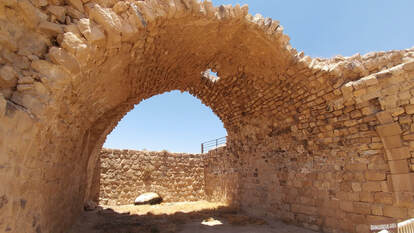 Al Karak, June 17, 2019 Al Karak, an ancient town in Jordan, is known for its fortified summit which dates to the Moabite and Nabatean periods. During the period of Byzantine Christianity Al Karak was also the seat of the Bishop. The castle standing on the summit was constructed during the 12-century Crusader period. As I examine the layers of bricks, dining room, kitchen, bedrooms, and stable, what stands out is the strategic position of this Crusader fortress, looking across the Moab plains, identifying threats in the vicinity. Al Karak has been inhabited by ancient Christian communities dating to the time of Jesus Christ and remained predominantly Christian until the Muslim penetration into the region in the 7th century. The fortresses served the Crusaders to defend the expansion of the Jerusalem Kingdom. The Crusader expeditions were launched from Roman Catholic Christendom as the Byzantine Empire and its Church had fallen to Islam. The responsibility was left to the Roman pontiff and the Western monarchs to launch and support the Crusades. The holy sights associated with Jesus and His Mother, and vulnerable pilgrims visiting these sights, required protection. The distance from their Christian brethren, the threat of a religion that was replacing Byzantine Christianity across the middle East southern Europe, and norther Africa, meant the Crusaders were geographically isolated finding themselves in the vulnerable position of having to rely on support and supplies coming from Europe. Establishing a permanent kingdom in Jerusalem in the 11th century, a definitive answer to an ongoing problem of the loss of Christian communities and endangered pilgrims. The Crusader castle was only in the area for 46 years from 1142 in the region referred to as Oultrejordain. From Al Karak Reynald de Chatillon, Lord of Oultrejordain, controlled Saladin’s major routes between Syria and Egypt. Saladin who had attempted several times to take the fortress, succeeded after a 1-year siege in 1188. Chatillon led offensive attacks, protecting the Jerusalem Kingdom. Though Roman Catholic “foreigners” -- therefore “occupants” -- of the region, as Christians they were not newcomers. The Crusaders identified with the Christian faith and the religious shrines extending into the Biblical lands of the eastern Mediterranean needed to be defended. When captured, just before his execution, Chatillon had the option of converting to Islam and saving his life. Chatillon refused conversion, remained a Roman Catholic and was beheaded by Saladin. Why should the Crusaders have engaged in these perilous expeditions? The Byzantine Christians hardly considered them their co-religionists; the conditions were fragile given their geographic vulnerability; the Crusaders engaged in bloody battles incompatible with the teachings of Christ. With the high risks and high stakes, what purpose did these Crusades really serve? History would re-write events treating the Crusaders as wicked, sadistic and ruthless. Western authors and non-Christian authors would offer a garbled mantra of criticism. At the end, why help the Eastern Christians if the cost is high, risking one’s life, and the reward, perhaps heaven for those who believed, but most certainly to be written in the annals of history viewing the Crusaders with derision, contempt, and blatant animosity. At Al Karnak fortress, nothing is said about the Crusader Church. The empty Church with a fragile arch looks desolate, waiting for a final collapse.
0 Comments
Your comment will be posted after it is approved.
Leave a Reply. |
AuthorFr. David Bellusci, O.P. List by Titles
Archives
May 2023
Categories
All
|
 RSS Feed
RSS Feed